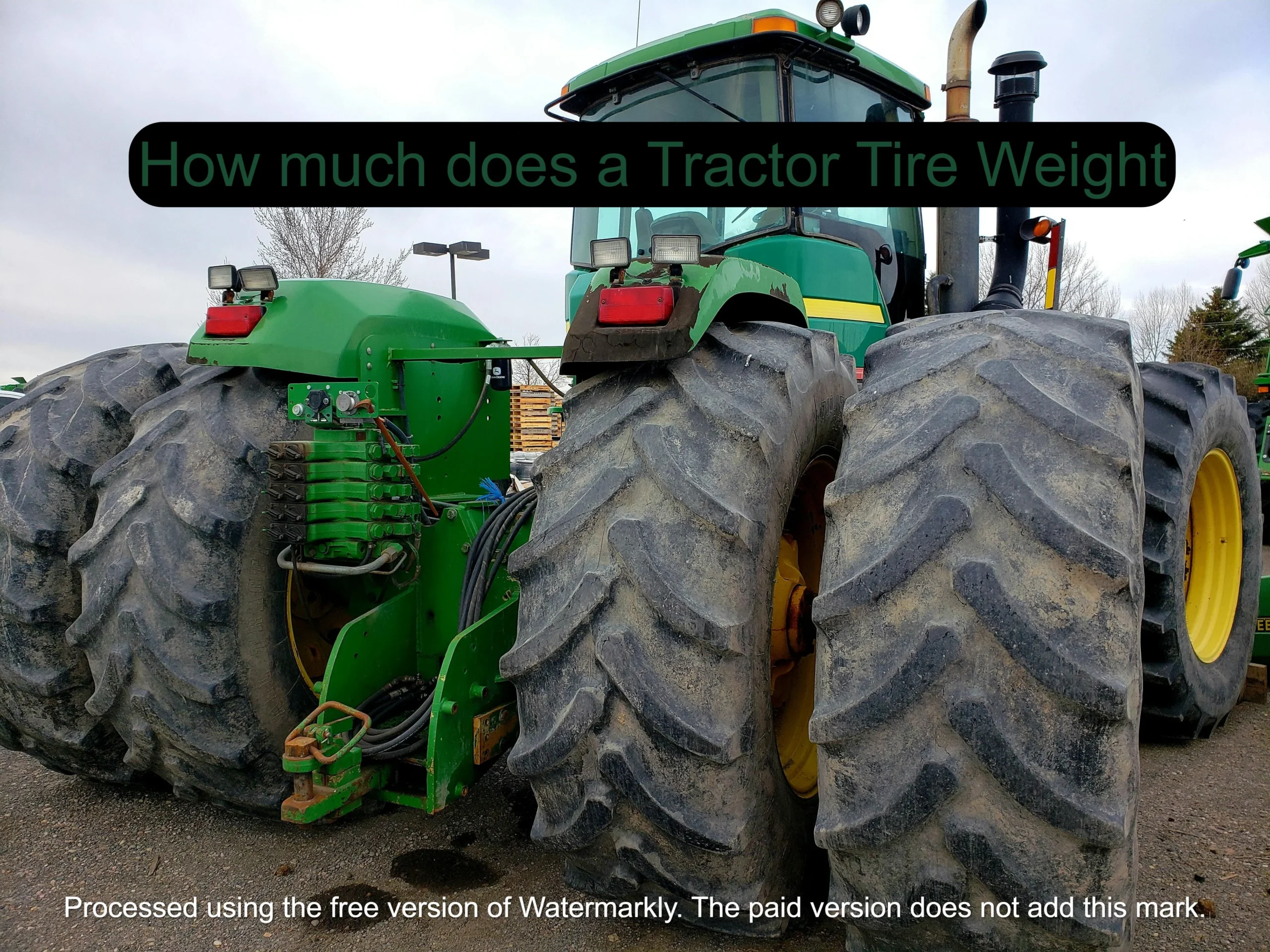A tractor tire’s weight varies depending on its size and type, but on average, they can weigh anywhere from 100 to 500 pounds. These heavy-duty tires are designed to support the weight of agricultural machinery and withstand rough terrain, making them essential for farming operations worldwide.
Introduction
In the world of agriculture and heavy machinery, tractor tires play a crucial role in ensuring efficient operations and productivity. These tires are designed to withstand the rigors of working on various terrains, carrying immense loads, and providing the necessary traction for optimal performance. However, the weight of these tires is often overlooked, despite being an essential factor in equipment maintenance, fuel efficiency, and overall operational costs. This article delves into the intricate details of tractor tire weights, exploring the factors that influence their heft, the importance of understanding these weights, and the implications they have on various aspects of tractor operations.
Understanding Tractor Tire Weights
Factors Influencing Tractor Tire Weight
Tractor tires are engineered to meet specific requirements, and their weight is influenced by several factors. These include:
- Tire Size: The overall dimensions of the tire, including the width, height, and diameter, play a significant role in determining its weight. Larger tires generally weigh more due to the increased amount of rubber and reinforcement materials used in their construction.
- Tire Construction: The construction method employed in the manufacturing process affects the weight of the tire. Radial tires, which are more common in modern tractors, tend to be lighter than their bias-ply counterparts due to their advanced construction techniques and materials.
- Tread Design: The tread pattern and depth of the tire influence its weight. Tires with deeper and more aggressive tread patterns, designed for improved traction in challenging terrains, typically weigh more than those with shallower treads.
- Reinforcement Materials: The type and quantity of reinforcement materials used in the tire’s construction, such as steel belts or nylon cords, contribute to its overall weight. These materials provide strength and durability but also add to the tire’s heft.
- Tire Compound: The rubber compound used in the tire’s construction can impact its weight. Certain compounds are denser or require additional reinforcement, resulting in increased weight.
Importance of Understanding Tractor Tire Weights
Knowing the weight of tractor tires is crucial for several reasons:
- Load Capacity and Traction: Proper tire weight distribution is essential for maintaining traction and ensuring the tractor’s load capacity is not exceeded. Overloading tires can lead to premature wear, reduced fuel efficiency, and increased risk of tire failure.
- Equipment Maintenance: Excessive tire weight can put additional strain on suspension systems, bearings, and other components, leading to increased maintenance costs and potential equipment breakdowns.
- Fuel Efficiency: Heavier tires require more energy to rotate, resulting in higher fuel consumption and operating costs. Understanding tire weights can help optimize fuel efficiency by selecting the appropriate tire size and construction.
- Transportation and Logistics: When transporting tractors or replacement tires, accurate weight information is necessary for proper loading and compliance with transportation regulations.
- Cost Considerations: Tire weight can impact the overall cost of ownership, as heavier tires may require more robust suspension systems, increased fuel consumption, and potentially higher transportation costs.

Tractor Tire Weight Ranges
To provide a better understanding of tractor tire weights, the following table presents typical weight ranges for various tire sizes commonly used in the agricultural industry:
| Tire Size | Weight Range (lbs) |
|---|---|
| 14.9R24 | 140 – 170 |
| 16.9R28 | 180 – 220 |
| 18.4R34 | 270 – 330 |
| 20.8R38 | 350 – 430 |
| 24.5R32 | 400 – 490 |
| 30.5R32 | 580 – 710 |
| 35.5R32 | 720 – 880 |
| 38.0R32 | 800 – 980 |
It’s important to note that these weight ranges are approximate and can vary depending on the specific tire model, construction, and reinforcement materials used by different manufacturers.
Radial vs. Bias-Ply Tires
When it comes to tractor tires, the choice between radial and bias-ply construction can significantly impact the overall weight. Radial tires, which feature crisscrossing steel belts reinforced with nylon cords, are generally lighter than their bias-ply counterparts. This weight advantage is due to the more efficient distribution of forces within the tire’s structure, allowing for a lighter construction while maintaining the necessary strength and durability.
Bias-ply tires, on the other hand, have a crisscrossing pattern of nylon cords embedded in the rubber plies, resulting in a heavier overall weight. While bias-ply tires were once the industry standard, radial tires have become increasingly popular due to their superior performance, improved fuel efficiency, and longer tread life.
Weight Distribution and Ballasting
Proper weight distribution and ballasting are essential for optimal tractor performance and minimizing soil compaction. Ballasting involves adding weight to the tractor’s wheels or frame to increase traction and stability, particularly when operating on sloping or challenging terrains.
While heavier tires can provide increased traction, excessive weight can lead to soil compaction, which can negatively impact crop yields and soil health. Striking the right balance between tire weight, ballasting, and overall equipment weight is crucial for efficient and sustainable agricultural practices.

Tractor Tire Weight in Practice
Impact on Fuel Efficiency and Operating Costs
The weight of tractor tires plays a significant role in fuel efficiency and operating costs. Heavier tires require more energy to rotate, resulting in increased fuel consumption and higher operating costs over time. This impact is particularly noticeable in tractors used for extensive field operations or long-distance transport.
To illustrate the potential savings, let’s consider a scenario where a tractor is equipped with lighter radial tires instead of heavier bias-ply tires. Assuming a weight reduction of 200 pounds per tire and an average fuel consumption of 10 gallons per hour, the lighter tires could result in a fuel savings of approximately 2-3% over the course of a typical workday.
While this may seem insignificant at first glance, the cumulative effect over an entire growing season or year can translate into substantial cost savings for farm operations, especially when factoring in the rising costs of fuel and the potential environmental benefits of reduced emissions.
Tire Selection and Equipment Compatibility
When selecting tractor tires, it is crucial to consider not only the weight but also the compatibility with the existing equipment. Mismatched tire weights can lead to uneven weight distribution, potentially causing premature wear, handling issues, and increased strain on the tractor’s components.
Manufacturers provide specific guidelines and recommendations for tire sizes and weights based on the tractor’s specifications, such as engine power, gross vehicle weight rating (GVWR), and intended use. Consulting these guidelines and working closely with tire experts can ensure the right tire selection, optimizing performance, safety, and longevity of the equipment.
Transportation and Logistics Considerations
The weight of tractor tires also plays a significant role in transportation and logistics. When transporting tractors or replacement tires, accurate weight information is necessary for proper loading, compliance with transportation regulations, and ensuring the safety of both the cargo and the personnel involved.
Overloading trucks or trailers with excessively heavy tires can lead to potential safety hazards, increased fuel consumption, and increased wear and tear on the vehicles. Additionally, inaccurate weight information can result in fines or legal complications due to non-compliance with weight limits and regulations.
By carefully considering the weight of tractor tires during transportation and logistics planning, farm operators and equipment dealers can optimize their operations, minimize costs, and ensure compliance with relevant laws and regulations.
Tractor Tire Weight Reduction Strategies
Advancements in Tire Technology
Tire manufacturers are continuously investing in research and development to create lighter and more efficient tractor tires without compromising performance or durability. Advancements in materials science and manufacturing processes have led to the development of innovative tire designs that offer weight reduction while maintaining the necessary load-bearing capabilities.
Some of the strategies employed by tire manufacturers include:
- Lightweight Reinforcement Materials: The use of advanced reinforcement materials, such as high-strength steel cords or aramid fibers, allows for a lighter overall tire construction while maintaining the required strength and durability.
- Optimized Tread Designs: By carefully engineering the tread patterns and optimizing the rubber compound formulations, manufacturers can reduce the amount of material needed without sacrificing traction or wear resistance.
- Advanced Manufacturing Techniques: Techniques like precision molding, computer-aided design, and automated production processes contribute to more efficient tire construction, minimizing material waste and ensuring consistent quality.
- Aerodynamic Designs: Aerodynamically optimized tire designs can reduce rolling resistance, resulting in improved fuel efficiency and potentially lower operating costs.
These advancements in tire technology not only contribute to weight reduction but also offer potential benefits in terms of increased fuel efficiency, reduced soil compaction, and extended tire life, ultimately leading to cost savings and environmental benefits for farm operations.

Tire Maintenance and Monitoring
Proper tire maintenance and monitoring can play a significant role in minimizing the impact of tire weight on equipment performance and operating costs. Regular inspections, appropriate inflation pressures, and timely replacement of worn or damaged tires can help optimize fuel efficiency, prevent premature wear, and ensure the safe operation of tractors and other agricultural machinery.
Additionally, implementing tire monitoring systems can provide valuable data on tire pressure, temperature, and wear patterns, enabling proactive maintenance and timely interventions. By addressing potential issues before they escalate, farm operators can extend the lifespan of their tires and minimize the associated costs and downtime.
Conclusion
Understanding the weight of tractor tires is essential for optimizing equipment performance, minimizing operating costs, and ensuring sustainable agricultural practices. This comprehensive guide has explored the factors influencing tractor tire weights, the importance of considering these weights, and the strategies employed by manufacturers to reduce tire weight while maintaining performance and durability.
By carefully selecting the appropriate tires, implementing proper maintenance practices, and embracing advancements in tire technology, farm operators can achieve better fuel efficiency, reduced soil compaction, and extended equipment longevity. Additionally, accurate weight information is crucial for transportation and logistics planning, ensuring compliance with regulations and minimizing potential safety hazards.
As the agricultural industry continues to evolve, the emphasis on sustainable and efficient practices will only increase. Tractor tire weight, once an overlooked aspect, now plays a pivotal role in achieving these goals. By staying informed and leveraging the insights provided in this guide, farm operators, equipment dealers, and industry stakeholders can make informed decisions that ultimately contribute to the profitability and sustainability of their operations.
FAQs
- How does tire weight affect fuel efficiency? Heavier tires require more energy to rotate, resulting in increased fuel consumption. Lighter tires can contribute to improved fuel efficiency, translating into cost savings and reduced environmental impact.
- What is the difference between radial and bias-ply tires in terms of weight? Radial tires are generally lighter than bias-ply tires due to their advanced construction techniques and materials. The crisscrossing steel belts and nylon cords in radial tires allow for a lighter overall weight while maintaining strength and durability.
- How important is proper weight distribution and ballasting for tractor performance? Proper weight distribution and ballasting are crucial for optimal tractor performance and minimizing soil compaction. Striking the right balance between tire weight, ballasting, and overall equipment weight is essential for efficient and sustainable agricultural practices.
- What are some strategies employed by tire manufacturers to reduce tire weight? Tire manufacturers are exploring the use of lightweight reinforcement materials, optimized tread designs, advanced manufacturing techniques, and aerodynamic designs to reduce tire weight without compromising performance or durability.
- How can regular tire maintenance and monitoring contribute to minimizing the impact of tire weight? Regular inspections, proper inflation pressures, and timely replacement of worn or damaged tires can help optimize fuel efficiency, prevent premature wear, and ensure the safe operation of tractors and agricultural machinery. Additionally, implementing tire monitoring systems can provide valuable data for proactive maintenance and interventions.
